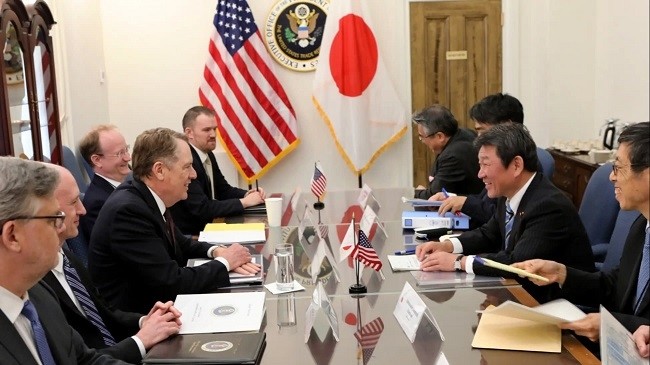Japanese and American press sources said that before the talks, both sides expressed their goodwill. US Trade Representative Robert Lighthizer welcomed the Japanese delegation, led by Japan’s economy minister Toshimitsu Motegi, to Washington to conduct two days of negotiations on a series of important issues on bilateral trade. The two sides will enter into negotiations for a Japan-US trade agreement on goods, as well as on other key areas including services, that can produce early achievements.
Minister Motegi told reporters that the two sides discussed trade issues involving goods, including agriculture, as well as the need to establish high standards in the area of digital trade. Meanwhile, US Trade Representative Robert Lighthizer raised the “very large” trade deficit with Japan (US$67.6 billion in 2018), urging the country to address the trade imbalances between the world’s largest and third-largest economies. In addition, the two sides also agreed that they would meet again in the near future. Motegi also said he is planning to have another meeting with Lighthizer ahead of the summit between PM Abe and President Trump that is likely to be held April 26 in Washington.
The two sides’ willingness to meet again soon in order to conduct the next round of trade negotiations is considered a good sign for the US-Japan trade negotiations in the context that a number of trade disagreements between the two countries still exist. US President Trump once voiced a complaint about the ‘unfair’ trade situation for many years between Japan and the US.
Analysts said that the US government conducted trade negotiations with Japan with an aim to concretise President Trump’s “America First” policy in trade. Over recent years, the US has pushed for renegotiations with major trading partners in the direction of signing agreements with specific countries instead of signing multilateral agreements. The US has completed a new North American Free Trade Agreement with Canada and Mexico, and a trade deal with the Republic of Korea. The US is also actively negotiating to reach a more favourable trade agreement with China, while preparing to launch a similar process of trade negotiations with the European Union (EU).
However, in the way ahead, negotiators from the US and Japan will face many difficulties. For example, Japan will not easily accept concessions for agricultural import tariffs. After the talks on April 16, Minister Motegi said Japan will not reduce tariffs on US farm products beyond levels the country has agreed in other trade pacts such as the Comprehensive and Progressive Agreement for Trans-Pacific Partnership (CPTPP) and the Japan – EU Free Trade Agreement.
In addition, Japanese leaders currently support free trade and disapprove of the US trade protection policy. Japanese PM Abe has recently called for the rebuilding of trust in the free trade system. He underscored the importance of a cross-border free trade system and hoped that the issue would be discussed at the G20 Summit scheduled to be held Japan in June.
However, with the Japanese PM’s visit the US at the end of April and the US President’s visit to Japan shortly afterwards, analysts expect that the two countries will soon resolve their disagreements.
















